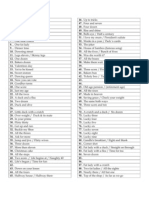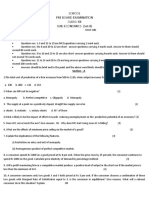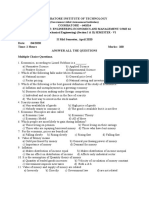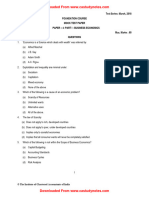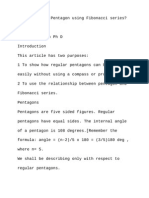CBSE SAMPLE PAPER-01 (Solved) Economics Class - XII
CBSE SAMPLE PAPER-01 (Solved) Economics Class - XII
Uploaded by
Hema NarulaCopyright:
Available Formats
CBSE SAMPLE PAPER-01 (Solved) Economics Class - XII
CBSE SAMPLE PAPER-01 (Solved) Economics Class - XII
Uploaded by
Hema NarulaOriginal Description:
Original Title
Copyright
Available Formats
Share this document
Did you find this document useful?
Is this content inappropriate?
Copyright:
Available Formats
CBSE SAMPLE PAPER-01 (Solved) Economics Class - XII
CBSE SAMPLE PAPER-01 (Solved) Economics Class - XII
Uploaded by
Hema NarulaCopyright:
Available Formats
CBSE SAMPLE PAPER-01 (solved)
ECONOMICS
Class – XII
Time allowed: 3 hours Maximum Marks: 100
General Instructions:
a) All questions are compulsory.
b) The question paper comprises of two sections, A and B. You are to attempt both the sections.
c) Questions 1 to 5 in section A and 16 to 18 in section B are MCQ’s of one mark each. Choose
the correct option.
d) Questions 6 to 8 in section A and 19 to 23 in section B are three marks questions. These are
to be answered in about 30 words each.
e) Questions 9 to 11 in section A and 24 to 25 in section B are four marks questions. These are
to be answered in about 50 words each.
f) Questions 12 to 15 in section A and 26 to 29 in section B are six marks questions. These are
to be answered in about 70 words each.
Section A
1. The central problem of economics of choosing the technique of production is the problem of:
a) What to produce b) How to produce
c) For whom to produce d) None of the above
2. Which of the following would be substitutes?
a) Bread and butter b) Car and petrol
c) Tea and coffee d) All of the above
3. When demand for a good falls due to rise in its own price, what is the change in demand
called?
a) Expansion of demand b) Contraction of demand
c) Increase in demand d) Decrease in demand
4. PPC can be a straight line when:
a) MRT is diminishing b) Constant MRT
c) Increasing MRT d) All of the above
5. Budget line is:
a) Parallel to X – axis b) Parallel to Y-axis
c) Downward sloping line d) None of the above.
6. Explain the problem of “what to produce” with the help of PPC.
Material downloaded from http://myCBSEguide.com and http://onlineteachers.co.in
Portal for CBSE Notes, Test Papers, Sample Papers, Tips and Tricks
7. Complete the following table:
Output (units) 1 2 3 4
TR (Rs.) 4 6 6 4
MR (Rs.)
AR (Rs. )
8. Explain three causes of the rightward shift of the supply curve.
9. Explain the causes behind the law of demand.
10. Distinguish between AFC and AVC. How are these calculated?
11. Suppose that the demand curve for XYZ Co. slopes downwards to the right. Would you
conclude that the firm is a price maker or a price taker? Give reason.
12. Explain briefly the features of perfect competition.
13. Market for a good is in equilibrium. What is the effect on equilibrium price and quantity if
increase in market demand is less than the increase in market supply? Use diagram.
14. Explain the law of supply. Use diagram.
15. Explain the effect of following changes on the demand for the commodity with the help of
diagram:
a) a fall in price of substitute goods
b) a favourable change in the taste of buyer.
SECTION B
16. Which of the following is a micro-economic study?
a) Level of employment b) Aggregate demand
c) Study of a cotton textile industry d) All of the above.
17. Which of the following is equal to National Income?
a) GDPFC b) NNPFC
c) NNPMP d) GNP
18. If inflation is higher in country A than in country B and the exchange rate between the
two countries is fixed, what is likely to happen to trade balance of Country A?
a) Trade balance of country A will be favourable
b) trade balance of country A will be Unfavourable
c) Trade balance of country A will be unaffected
Material downloaded from http://myCBSEguide.com and http://onlineteachers.co.in
Portal for CBSE Notes, Test Papers, Sample Papers, Tips and Tricks
d) None of the above.
19. Explain Paradox of thrift.
20. Distinguish between national income at current price and at constant price.
21. When will there be a situation of deficit demand in an economy? State two measures to
correct it.
22. Explain why Public goods must be provided by the government?
23. From the following data about firm X, calculate gross value added at factor cost by it:
(Rs. in thousands)
Sales 500
Opening stock 30
Closing stock 20
Purchase of intermediate products 300
Purchase of machinery 150
Subsidy 40
24. What is meant by open market operations? Briefly describe their effects on credit creation by
commercial banks.
25. Distinguish between Revenue receipts and capital receipts in a government budget. Give two
examples of each.
26. Explain main functions of the commercial bank.
27. How are following treated in the estimation of national income?
a) Transfer payments
b) Services of owner occupied houses.
c) Commission received from sale of second hand goods.
d) Non –marketable goods.
28. Explain the three categories in which BOP transactions are classified.
29. From the table given below:
Income Consumption Savings Investment AD= C+ I AS= Y
100 120 -20 40 160 100
200 200 0 40 240 200
300 280 20 40 320 300
Material downloaded from http://myCBSEguide.com and http://onlineteachers.co.in
Portal for CBSE Notes, Test Papers, Sample Papers, Tips and Tricks
400 360 40 40 400 400
500 440 60 40 480 500
600 520 80 40 560 600
Answer the following questions:
a) Identify the break-even point
b) Locate the equilibrium level of income.
c) Calculate MPS when income changes from Rs. 400 to Rs. 500.
d) Calculate APC at income level of Rs. 100 crores.
e) Calculate APS at income level of Rs. 500 crores.
Material downloaded from http://myCBSEguide.com and http://onlineteachers.co.in
Portal for CBSE Notes, Test Papers, Sample Papers, Tips and Tricks
You might also like
- Waec Econs Theory Ques 11 15Document24 pagesWaec Econs Theory Ques 11 15timothyNo ratings yet
- Gero - Exam 1 Study GuideDocument75 pagesGero - Exam 1 Study GuideTravis Hartsgrove100% (4)
- Econ 201 Past Midterm 2Document13 pagesEcon 201 Past Midterm 2SooHan MoonNo ratings yet
- Tambola Call OutsDocument2 pagesTambola Call OutsHema Narula50% (2)
- Economics Sample Paper 1Document3 pagesEconomics Sample Paper 1L IneshNo ratings yet
- Contentpage Tafssp 157 21Document3 pagesContentpage Tafssp 157 21Anonymous rePT5rCrNo ratings yet
- CBSE SAMPLE PAPER-3 (Solved) Economics Class - XIIDocument3 pagesCBSE SAMPLE PAPER-3 (Solved) Economics Class - XIIniharikaNo ratings yet
- 2017 12 Economics Sample Paper 02 QPDocument3 pages2017 12 Economics Sample Paper 02 QPahmadshahwaqarNo ratings yet
- Eco 162: Microeconomics: Website: Universiti Teknologi MaraDocument14 pagesEco 162: Microeconomics: Website: Universiti Teknologi MaraQaseh Acewin100% (1)
- CBSE SAMPLE PAPER 2 (Unsolved) Economics Class - XIIDocument3 pagesCBSE SAMPLE PAPER 2 (Unsolved) Economics Class - XIIVijay DhanakodiNo ratings yet
- Sample Paper-03 (2016-17) Economics Class - XII Time Allowed: 3 Hours Maximum Marks: 100 General InstructionsDocument3 pagesSample Paper-03 (2016-17) Economics Class - XII Time Allowed: 3 Hours Maximum Marks: 100 General InstructionsshaileshshrmaNo ratings yet
- 12 Economics Unsolved 04 NewDocument3 pages12 Economics Unsolved 04 NewBhumitVashishtNo ratings yet
- CAF-Business Economics PDFDocument40 pagesCAF-Business Economics PDFadnan sheikNo ratings yet
- Eco 162 Microeconomics PDFDocument22 pagesEco 162 Microeconomics PDFjungkook wifeNo ratings yet
- Mohit Educomp Pvt. Ltd. Main Centre-59 Jatindra Mohan Avenue 9830741471/8017567120/03325551197 Micro Economic Test Paper Time Allowed 1 HRDocument4 pagesMohit Educomp Pvt. Ltd. Main Centre-59 Jatindra Mohan Avenue 9830741471/8017567120/03325551197 Micro Economic Test Paper Time Allowed 1 HRRohit Kumar SwainNo ratings yet
- II PUC EconomicsDocument5 pagesII PUC EconomicsArvind KoreNo ratings yet
- Pre Board Eco Class 12Document3 pagesPre Board Eco Class 12Kusum VijaywargiyaNo ratings yet
- Sample Paper-05 (2016-17) Economics Class - XII Time Allowed: 3 Hours Maximum Marks: 100 General InstructionsDocument3 pagesSample Paper-05 (2016-17) Economics Class - XII Time Allowed: 3 Hours Maximum Marks: 100 General InstructionsshaileshshrmaNo ratings yet
- Mock Test 18 Economics CUET 24 by Sunil Panda - 35071990 - 2024 - 06!04!20 - 13Document14 pagesMock Test 18 Economics CUET 24 by Sunil Panda - 35071990 - 2024 - 06!04!20 - 13Saksham AgarwalNo ratings yet
- Binary DisplayDocument3 pagesBinary DisplayblessedoyeniyiNo ratings yet
- Xi Eco 2023Document4 pagesXi Eco 2023sindhuNo ratings yet
- II Mid Sem MECHDocument8 pagesII Mid Sem MECHPoonthamil VNo ratings yet
- Test 1 2020Document10 pagesTest 1 2020Buyisile NyongwanaNo ratings yet
- Eco Nov 2023 Test Paper With AnswersDocument6 pagesEco Nov 2023 Test Paper With Answersbaidshruti123No ratings yet
- 2021 HND ECONOMICS REVISionDocument4 pages2021 HND ECONOMICS REVISionDEREK DARRELNo ratings yet
- Paper 4 Part 1 Mock Paper PDFDocument11 pagesPaper 4 Part 1 Mock Paper PDFNikhilNo ratings yet
- Economics Course QuestionsDocument57 pagesEconomics Course QuestionsZunaira WaheedNo ratings yet
- Chapter 1 Review QuestionDocument3 pagesChapter 1 Review Questionalways11past11No ratings yet
- ECF100 2024 Semester 1 Final ExamDocument9 pagesECF100 2024 Semester 1 Final ExamchilupeesnartNo ratings yet
- ECO 111 - Tutorial Questions - October 2021Document8 pagesECO 111 - Tutorial Questions - October 2021Nɩʜɩɭɩstic Ucʜɩʜʌ SʌsʋĸɘNo ratings yet
- BB 107 Supplementary Exam Summer 2020 Q (Set A) (Online)Document6 pagesBB 107 Supplementary Exam Summer 2020 Q (Set A) (Online)Brewell CoNo ratings yet
- FCE BINF Question Pool SolvedDocument109 pagesFCE BINF Question Pool SolvedGertaNo ratings yet
- Final Exam 10Document15 pagesFinal Exam 10Nadira RoslanNo ratings yet
- Exam-2020-21 - Suggested AnswerDocument19 pagesExam-2020-21 - Suggested Answeralexevarist39No ratings yet
- Economics Term Exam 1 2024-25Document3 pagesEconomics Term Exam 1 2024-25sarathsivadamNo ratings yet
- 2019 11 Economics Ass 3 - Examination (Revised)Document18 pages2019 11 Economics Ass 3 - Examination (Revised)Amelia.MardhikasenaNo ratings yet
- Xii Economics QP EngDocument2 pagesXii Economics QP Engshadowyt367No ratings yet
- BBS 1st Year Business Economics 0009Document6 pagesBBS 1st Year Business Economics 0009Suzain Nath91% (11)
- Management Accounting (Pilot Paper)Document13 pagesManagement Accounting (Pilot Paper)Sujan SanjayNo ratings yet
- ECON2113 MC PracticeDocument44 pagesECON2113 MC Practicefish LNo ratings yet
- Eco 162: Microeconomics: Website: Universiti Teknologi MaraDocument14 pagesEco 162: Microeconomics: Website: Universiti Teknologi Maramsukri_81No ratings yet
- AS Level QuizDocument5 pagesAS Level Quizbijumon1484282No ratings yet
- Chapter 30 & 31 TestDocument11 pagesChapter 30 & 31 TestpdufferNo ratings yet
- EconomicsDocument3 pagesEconomicsomaryidd0764No ratings yet
- Sample Review Questions For FinalDocument17 pagesSample Review Questions For FinalJon Mckenzie GoNo ratings yet
- ECO Full MtpsDocument184 pagesECO Full MtpsGourav MittalNo ratings yet
- ECON 2113 - Multiple-Choice Practice QuestionsDocument49 pagesECON 2113 - Multiple-Choice Practice QuestionsMichael LeeNo ratings yet
- Class 11 - Economics - Holiday Homework (2024-25)Document6 pagesClass 11 - Economics - Holiday Homework (2024-25)Vaishnavi BhardwajNo ratings yet
- CA Foundation MTP 2020 Paper 4 QuesDocument15 pagesCA Foundation MTP 2020 Paper 4 QuesKanchan AggarwalNo ratings yet
- CA Foundation MTP 2020 Paper 4 QuesDocument15 pagesCA Foundation MTP 2020 Paper 4 QuesKanchan AggarwalNo ratings yet
- Revision Test-02 (4,5,6 & 7)Document4 pagesRevision Test-02 (4,5,6 & 7)Muhammad FaisalNo ratings yet
- Review QuestionsDocument5 pagesReview QuestionsNahid IbrahimzadeNo ratings yet
- set3Document9 pagesset3amanjani2929No ratings yet
- Managerial EconomicsDocument3 pagesManagerial EconomicsnaeemakhtaracmaNo ratings yet
- CSS Economics Last 10 Years Past Papers by BaltiDocument24 pagesCSS Economics Last 10 Years Past Papers by BaltiBalti100% (2)
- Economics - 2011Document4 pagesEconomics - 2011awaissharif0000No ratings yet
- Time Allowed: 3 Hours Maximum Marks: 100 General InstructionsDocument3 pagesTime Allowed: 3 Hours Maximum Marks: 100 General InstructionsManminder SinghNo ratings yet
- 2023 Economics II HEG HEL MEG LEG MCEDocument4 pages2023 Economics II HEG HEL MEG LEG MCEishimwef501No ratings yet
- MICROECONOMICS - Revison Notes 2013 S1 Ques Set 2Document6 pagesMICROECONOMICS - Revison Notes 2013 S1 Ques Set 2Imelda WongNo ratings yet
- Test 1version 2Document15 pagesTest 1version 2Rashid AyubiNo ratings yet
- Mock Eco 2Document3 pagesMock Eco 2Yusuph MndemeNo ratings yet
- Economic Indicators for Eastern Asia: Input–Output TablesFrom EverandEconomic Indicators for Eastern Asia: Input–Output TablesNo ratings yet
- Aus Mun Country MatrixDocument3 pagesAus Mun Country MatrixHema NarulaNo ratings yet
- 0CkNNo - HMW - 1495707025 - Worksheet For Grade 8Document2 pages0CkNNo - HMW - 1495707025 - Worksheet For Grade 8Hema Narula0% (1)
- 2 Scarcity and Trade Offs ReviewDocument73 pages2 Scarcity and Trade Offs ReviewHema NarulaNo ratings yet
- 06 2014 Full Proposal Writing Workshop Handout 2014Document3 pages06 2014 Full Proposal Writing Workshop Handout 2014Hema NarulaNo ratings yet
- Community HelpersDocument9 pagesCommunity HelpersHema NarulaNo ratings yet
- Singapore Science G3Document4 pagesSingapore Science G3Satiees SaNo ratings yet
- Botany Books PDFDocument3 pagesBotany Books PDFKarm JiNo ratings yet
- Sd9368-Ehldatasheet enDocument3 pagesSd9368-Ehldatasheet enEduardo Jimeno PolifroniNo ratings yet
- FES f4CgUXvt Sales IllustrationDocument27 pagesFES f4CgUXvt Sales Illustrationzhileng319.mpgNo ratings yet
- How To Draw A Pentagon Without Compass/protractor? - For School StudentsDocument10 pagesHow To Draw A Pentagon Without Compass/protractor? - For School StudentsDr Srinivasan Nenmeli -K100% (1)
- 2022 ICM Part 4Document58 pages2022 ICM Part 4amkamo99No ratings yet
- Who Am IDocument1 pageWho Am Iapi-528184284No ratings yet
- Io Chapter 1introductionDocument5 pagesIo Chapter 1introductionQueenie Alvarez DanganNo ratings yet
- Year 3 Literacy Homework ResourcesDocument8 pagesYear 3 Literacy Homework Resourcesafesbibdy100% (1)
- Writing Test 1: Building FlexibilityDocument6 pagesWriting Test 1: Building FlexibilityAN NGUYEN HOANG NHUNo ratings yet
- Sigils: LigisDocument21 pagesSigils: LigisMarc Rapp100% (1)
- Red Hat Enterprise Linux-6-Storage Administration Guide-En-USDocument224 pagesRed Hat Enterprise Linux-6-Storage Administration Guide-En-USPrasad NandamNo ratings yet
- Nike AjaxDocument12 pagesNike AjaxIshrat Hussain Turi100% (1)
- Manual ID 402Document25 pagesManual ID 402Jahangir AliNo ratings yet
- Bacterial Surface Contamination of Emergency in Ambulance During Patient ServiceDocument7 pagesBacterial Surface Contamination of Emergency in Ambulance During Patient ServiceanuragluminarNo ratings yet
- Nano-And Biocomposites: Emerging Nanotechnologies For ManufacturingDocument1 pageNano-And Biocomposites: Emerging Nanotechnologies For ManufacturingshahramNo ratings yet
- Revised Yarn Package Dyeing 08.2012Document45 pagesRevised Yarn Package Dyeing 08.2012Jadda TextileNo ratings yet
- CNC Milling Programing Guide PDFDocument52 pagesCNC Milling Programing Guide PDFSơn Đặng71% (7)
- NBCG 2024-1Document6 pagesNBCG 2024-1chevonneNo ratings yet
- Method Statement For Testing of BusductDocument11 pagesMethod Statement For Testing of Busductjimmuel mendozaNo ratings yet
- MEP 283 Lecture NotesDocument57 pagesMEP 283 Lecture NotesPkay TandohNo ratings yet
- Portfolio Analysis: By: Sareeta Yadav Roll No. 16 M. Com (FINANCE) 3 SEMDocument13 pagesPortfolio Analysis: By: Sareeta Yadav Roll No. 16 M. Com (FINANCE) 3 SEMsarita yadavNo ratings yet
- C13, C15, and C18 Engines Troubleshooting - Inlet Air Is Restricted Caterpillar Engines TroubleshootingDocument4 pagesC13, C15, and C18 Engines Troubleshooting - Inlet Air Is Restricted Caterpillar Engines Troubleshootingmohd arif fahmi mohamad salehNo ratings yet
- Discourse Community Map Essay RevisedDocument4 pagesDiscourse Community Map Essay Revisedapi-340395866No ratings yet
- A Real Time Approach For ECG Signal Denoising and Smoothing Using Adaptive Window TechniqueDocument6 pagesA Real Time Approach For ECG Signal Denoising and Smoothing Using Adaptive Window Techniqueعمار طعمةNo ratings yet
- Sampling System Procedimento para A Calibracao de Dissolved-Oxygen-Sensor-Rosemount-En-990776Document28 pagesSampling System Procedimento para A Calibracao de Dissolved-Oxygen-Sensor-Rosemount-En-990776Houston MacazeNo ratings yet
- Assignment 2Document3 pagesAssignment 2Alok PanigrahyNo ratings yet
- Sipmos Small-Signal Transistor: GS (TH)Document8 pagesSipmos Small-Signal Transistor: GS (TH)rolandseNo ratings yet
- The Effects of College Student Employment On Academic AchievementDocument11 pagesThe Effects of College Student Employment On Academic AchievementCarla Flor LosiñadaNo ratings yet



